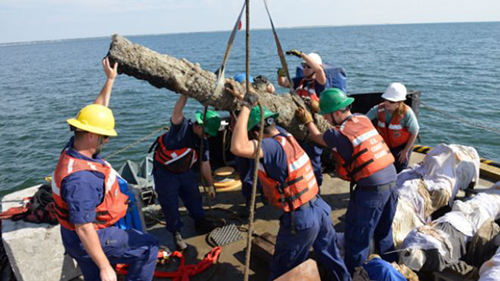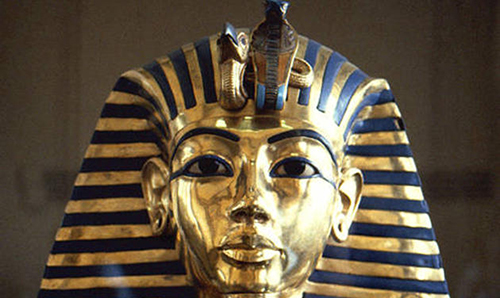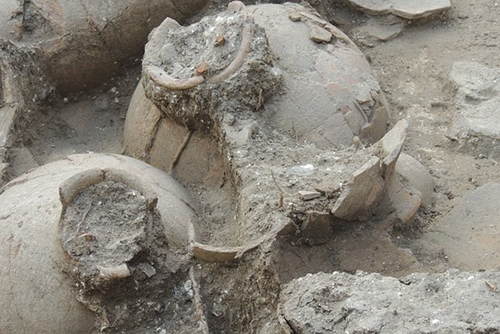Harry Potter and the narwhal tusk

A 130-year-old narwhal tusk engraved with the name of a character from the Harry Potter books has been sold at auction in England for a little more than $50,000, reportedly to an American maritime museum. Collector John Jeffries, 64, an Englishman, bought the tusk at auction himself around 20 years ago for about $3,000, but only recently noticed it was engraved with the name of Cornelius Fudge, a Navy man to whom it had been presented in 1881. That’s the name of the Minister of Magic in the Potter books.
Jeffries, astounded by this, wrote a letter to author JK Rowling, to tell her about his discovery. She wrote back: “How utterly extraordinary! No, I made up the name Cornelius – or thought I did. I had never come across it and did not know of the existence of a naval C.F. Thank you for a most interesting addition to the postbag. With very best wishes, JK Rowling.” Jeffries graciously donated 3 percent of the sale price of the tusk to a multiple sclerosis charity, knowing that Rowling’s mother had died of the disease at age 45.
Five cannons retrieved from Blackbeard’s ship

Archaeologists continue to pull up artifacts from the site where the pirate Blackbeard’s ship Queen Anne’s Revenge sank off the North Carolina coast in 1717. On one day in October, crews lifted five cannons out of the water, the heaviest weighing 3,000 pounds and the other four 2,000 pounds. Records show the Queen Anne’s Revenge – a French slave ship that Blackbeard captured and renamed, as a poke at the Queen of England – had 40 cannons. So far, 22 cannons have been raised from the ocean floor.
Five months after the ship sank, in Beaufort Inlet, Blackbeard was killed by volunteers from the Royal Navy. The wreck of the Queen Anne’s Revenge was only discovered in 1996. Since then, a staggering 280,000 artifacts have been recovered from the wreck. Archaeologists hope to recover all that remains by the end of next year, and it’s a race against time. They are worried about deterioration brought on by hurricanes that have hit the coast in recent years. The largest cannon just retrieved was made in Sweden.
Ringo: ‘All I’ve got is a photograph … ‘

Nearly 50 years ago, on Feb. 7, 1964, six students at Fair Lawn High School in Fair Lawn, N.J., gathered in the student lounge and decided to cut school and go see the Beatles. The Fab Four were landing in America for the first time, and students Gary Van Deursen, Suzanne Rayot, Arlene Norbe, Charles Schwartz, Bob Toth and Matthew Blender decided they just had to make the scene. So they hopped into Gary’s father’s Chevy Impala and headed to JFK airport. Little did they realize what awaited them.
The stay at JFK was uneventful. Police had barricaded off much of the area and the six had to strain just to catch a glimpse of the Lads from Liverpool in the distance. But on the drive back home, they were passed by four limousines – each one carrying a Beatle. Amazingly, as they ran parallel to one, Ringo rolled down his window, engaged them in conversation and even snapped their photo, which was used in his book Photographs. Only recently were the six kids who skipped school on that famous day identified.
Copy of Napoleon’s will brings $483,000

A copy of French emperor Napoleon’s will has been sold through the French auction house Druout for a reported 367,000 euros (or $483,000). The copy, written by an adviser to Napoleon, was purchased by a French collector who wished to remain anonymous. The will was dated April 16, 1821, just 19 days before the ailing leader’s death at age 51. In it, Napoleon stated he wanted his ashes spread over Paris’s Seine River. That never happened. The original will, penned by Napoleon, is in France’s national archives.
Rare Faberge figurine sells for $5.98 million

Executors going through items in the attic of George and Betty Davis in Rhinebeck, N.Y., made the discovery of a lifetime some months back. There, in a plain wooden box, was a Faberge portrait hardstone figure of Nikolai Nikolaievich Pustynikov, a loyal personal bodyguard to Russia’s Empress Alexandra Feodorovna. Tsar Nicholas II had commissioned the renowned artisans at Faberge to produce the figure for his wife Alexandra, in 1912. That was only a few years before the Russian Revolution.
The Davis estate commissioned Stair Galleries in Hudson, N.Y., to auction the figure, which it did this fall. The figure carried a presale estimate of $500,000-$800,000, but it ended up selling for $5.2 million ($5.98 million with the buyer’s premium). The buyer was the noted London-based jeweler Wartski, which specializes in the work of Carl Faberge and Russian works of art. Only 50 portrait figures were known to have been carved by Faberge. They are as rare as the more highly publicized imperial Easter eggs.
Water damage shuts down Titanic exhibit

An exhibition of Titanic artifacts in Atlanta had to be temporarily shut down – because of water damage. The ironic turn of events happened at “Titanic: The Artifact Exhibition,” currently on view at Atlantic Station, an upscale mixed-use development in the city’s downtown. The interruption lasted only part of one day and the source of the water was never made public. The exhibition features hundreds of objects recovered from the doomed ocean liner, plus historically accurate recreations of rooms aboard the ship.
Fire engine in old photograph restored

The very same 1921 American LaFrance fire truck that was shown in a photo from a 1937 flood in New Albany, Ind., has been fully restored and was recently unveiled at the Vintage Fire Museum and Education Center’s annual chili cook-off in New Albany. The fire engine was captured in a photo that ran in newspapers nationwide at the height of the Great Depression, after firefighters had placed it on a raft so they could wade it through the flooded city streets. The fire engine will eventually be moved to Jeffersonville, Ind.
’53 motorcycle stolen in ’67 finally recovered

A 1953 Triumph Tiger 100 motorcycle stolen out of a man’s backyard in Omaha, Neb., in 1967 has been recovered. The bike was about to be shipped to Yokohama, Japan, when U.S. Customs and Border Protection agents in Los Angeles got suspicious and decided to scrutinize the paperwork. That’s when they discovered the vehicle identification number matched that of the stolen bike. The Triumph, thought to be worth around $9,000, was reunited with its owner, now 72 and living in Nebraska.
Confiscated ivory is gathered, crushed

A global ban on the ivory trade has been in effect since 1989, but that hasn’t stopped poachers in Asia and Africa, who were responsible for the slaughter of 32,000 elephants last year. Most of the killings took place in Africa, where there are around 300,000 elephants left. In Asia (from India to Vietnam) the number is 50,000 elephants. Poaching is at an all-time high, thanks in large part to growing demand in the U.S. and Asia. Now, U.S. officials have come up with a novel approach to discouraging poachers.
In November, the U.S. Fish and Wildlife Service in Denver gathered up more than six tons of confiscated ivory tusks, carvings and jewelry – most of what comprises the co-called “blood ivory” stockpile – piled it into a large mound and pulverized it using rock-crushing heavy equipment. They urged other nations to follow suit, to send a message to poachers in an attempt to curb the global trade of ivory, which is a $10 billion enterprise. Destroyed were tusks, ceremonial bowls, statues, masks, ornaments and other objects.
Toy Hall of Fame new inductees: ducks, chess

The National Toy Hall of Fame announced its new inductees for the class of 2013: the rubber duck and the game of chess. They beat out 10 other finalists: bubbles, the game of Clue, Fisher-Price’s Little People, little green Army men, the Magic 8 Ball, My Little Pony, Nerf toys, Pac-Man video game, the Teenage Mutant Ninja Turtles and the scooter. Online voting had My Little Pony and the Teenage Mutant Ninja Turtles running neck and neck, but in the end a national selection committee made the final choices.
King Tut may have died in a chariot crash

Much speculation has been made regarding just how the legendary “Boy King” Tutankhamen perished. His body appeared to be burned when it was discovered in 1922, by the archaeologists Howard Carter and George Herbert. Now, British researchers, led by Chris Naunton, an Egyptologist, after working with experts in modern vehicle crashes, are saying Tut was on his knees when he was run over and killed by a chariot, possibly during battle. And the charred body? Possibly spontaneous combustion, caused by a botched mummification effort. That happened after his burial, the researchers believe.
Little Red Riding Hood predates Brothers Grimm

The story of Little Red Riding Hood has been a favorite of children the world over since it was first published as Rotkappchen by the Brothers Grimm in Germany in 1812 – right? Wrong. Turns out the Grimm version was heavily borrowed from a French telling of the story that had been around 200 years longer. And before that, another version, known as The Wolf and the Kids, was in oral circulation in Europe and the Middle East for about 1,000 years. There are nearly 60 versions of Little Red Riding Hood in all.
Scientists, using phylogenic methods (usually used to study the origin of species), studied cross-cultural relationships from Europe, the Middle East, Asia and Africa as they pertain to this one classic children’s fairy tale. Their conclusion: The Wolf and the Kids oral version was the first, followed by Perrault’s French telling and the Chinese poet Huang Zhing’s version known as the Tiger Grandmother in the 1600s. The Brothers Grimm got all the credit but they basically cobbled together a tale that had been around for ages.
Wild Bill Hickok’s gun fails to sell at auction

The Smith & Wesson No. 2 revolver that Wild West legend James “Wild Bill” Hickok was carrying the day he was shot and killed during a card game in 1875 failed to sell at auction after bidders fell short of the reserve. The gun – a 6-inch barrel pistol, with blued finish steel and rosewood grips – was in overall good condition despite a few cracks and mild bulges in front of its breech. But the fact that it was Hickok’s pistol made it desirable to collectors and led auction house Bonhams to start the bidding at $150,000.
However, the most anyone was willing to pay was $220,000, against an aggressive presale estimate of $300,000-$500,000. The revolver may be offered again in a future auction. Or it’s possible someone will call Bonhams and meet the reserve price (an amount known only to the seller and Bonhams). Hickok was playing poker at the Nuttal & Mann’s Saloon in Deadwood, S.D., when he was shot from behind by Jack “Crooked Nose” McCall. The seller acquired the coveted revolver in the early 1970s.
Mayor Rob Ford has his own bobble doll

It was bound to happen: Toronto’s embattled Mayor Rob Ford has his own bobblehead doll. The 6-inch-tall statuettes went on sale in November at a cost of $20 Canadian ($19US) and within hours some were showing up on eBay for as much as $300. Only 1,000 of the dolls were made, and the line to buy one, at Toronto’s City Hall, snaked around the lobby and out into the street. Ford himself was on hand to sign the figurines.
The bobbleheads were conceived before Ford burst onto the international stage with the bizarre admission that he’d smoked crack cocaine while in office. Proceeds from the sale of the dolls will go to benefit the United Way charity, and Ford has promised that more of the dolls will be manufactured. The mayor confessed to the crack cocaine allegations after a video surfaced showing him smoking the illegal substance. In another video, Ford was shown going off on an expletive-filled rant while high.
Vintage wine dates back to 1700 B.C.

Archaeologists digging at an ancient Canaanite city in northern Israel have discovered what amounts to an ancient wine cellar – a storage room filled with the equivalent of about 3,000 bottles of red and white wines thought to be from around 1700 B.C. All 40 of the 6-foot-tall ceramic jars were broken, and their liquid contents were long gone, but a chemical analysis of the residue showed organic traces of acids that are common to all wines, ancient and modern. The presence of tartaric acid was especially revealing.
The residue also featured traces of ingredients popular in ancient wine making, such as honey, mint, cinnamon bark, juniper berries and preservative resins. The archaeologists say they’ll be able to produce a reasonable facsimile of the ancient wine, for consumption, just to taste what people in centuries past swigged at feasts. The Canaanite dig site, known as Tel Kabri, was home to a palace, banquet hall and wine storage room. These were all destroyed some 3,600 years ago in a cataclysmic event, possibly an earthquake.



